Azar Gat, with Alexander Yakobson
Nations: The Long History and Deep Roots of Political Ethnicity and Nationalism
Cambridge: Cambridge University Press, 2013
Israeli historian Azar Gat makes the case that ethnic nationalism has deep roots in human history and human nature in this detailed and wide-ranging historical survey of ethnicity and the nation-state. This is a useful book for White Nationalists because it provides an abundance of evidence attesting to the enduring importance of ethnicity and the pitfalls of diversity. I will summarize the most noteworthy points here.
Gat classifies his opponents as “modernists,” who argue that the phenomenon of nationalism is exclusive to the modern era, and “instrumentalists,” Marxists who see nationalism as a form of class-based social manipulation. As he points out, most instrumentalists are also modernists. Common to both viewpoints is the belief that, in the words of Jewish writer Ernest Gellner, “nationalism does not have any very deep roots in the human psyche” (p. 25).
The defining attributes of a nation are ethnic kinship, a shared culture, and self-government. By these criteria, nation-states existed long before nationalism is said to have been “invented.” The technological, economic, and social changes of the modern era had an indelible impact on the political expression of nationalist sentiments, but the nation-state was not a product of modernity.
 Local identity was paramount for many pre-modern peoples, but a sense of overarching ethnic identity was also potent. Pre-modern peoples considered themselves distinct entities united by blood ties, language, and a common religion. Gat argues that modern historians exaggerate the extent to which pre-modern ethnic groups were internally divided by linguistic differences. Though local dialects existed, language was generally a powerful unifying factor. Shared religious practices and beliefs were reinforced by a “network of cultic and congregational sites,” as well as wandering bards (p. 11).
Local identity was paramount for many pre-modern peoples, but a sense of overarching ethnic identity was also potent. Pre-modern peoples considered themselves distinct entities united by blood ties, language, and a common religion. Gat argues that modern historians exaggerate the extent to which pre-modern ethnic groups were internally divided by linguistic differences. Though local dialects existed, language was generally a powerful unifying factor. Shared religious practices and beliefs were reinforced by a “network of cultic and congregational sites,” as well as wandering bards (p. 11).
Contrary to the instrumentalists, the masses shared in this ethnic identification. Their illiteracy was not an obstacle; ordinary people participated in festivals, dances, and games that celebrated their heritage and reinforced their shared identity. They also fought fiercely against foreign invaders. Even when class relations were acrimonious (which was often the case), the masses invariably sided with their own nobles over foreign commoners. Naturally, we do not have a record of what they thought and felt, but it is significant that the people lent their support to nationalism as soon as they had a voice of their own and were able to participate in politics.
The masses were not “manipulated” to defend their nations. They did so freely and displayed a striking willingness to fight and die for their kinsmen. The impetus behind this phenomenon is humans’ innate preference for their own kind, which Gat discusses in the second chapter. Evolution selected for this trait because it enabled humans to bond more effectively and function better as a group in the face of threats. Kinship in turn emerged as the central organizing principle of human societies.
The nation-state is indeed a recent phenomenon in a broad sense. Anatomically modern humans have been around for two to three hundred thousand years (the genus Homo having emerged around two million years ago), but the first states did not emerge until about five thousand years ago. For most of human history, humans existed as hunter-gatherers whose group affiliation was confined to their respective clans. Local customs and codes of dress and behavior came about as a means to cement these bonds and distinguish between one’s own tribe and foreign tribes. The concept of kinship expanded with the advent of agriculture, which allowed societies to sustain larger populations, but it remained of central importance.
Of course, as Gat notes, the element of culture is equally important. A Dane who is equally related to a given Norwegian as he is to a fellow Dane would likely feel a greater sense of brotherhood with the Dane simply due to their shared cultural background. Danes, Swedes, and Norwegians are genetically very similar to each other, and state formation in Scandinavia could conceivably have followed a different trajectory under different circumstances. Similarly, early Germanic and Slavic ethnic designations were fairly fluid and “experienced a great deal of fusion and fission, mixing older tribal entities and newly formed war bands” (p. 141). One could grant, then, that there is an extent to which identity is socially constructed and subject to historical contingencies. Nonetheless, this does not negate the fact that shared genetic heritage is a necessary condition for nationhood.
The centrality of ethnicity is seen in the kinship between diaspora communities and their respective homelands. For instance, Finland granted citizenship rights to about twenty-five thousand ethnic Finns outside Finland following the collapse of the Soviet Union.
It is this sense of kinship (both ethnic and cultural) that motivates people to sacrifice their lives for their countries. Gat writes:
Thus, to the bewilderment of the ideologues of the Second International, when the First World War broke out the workers in each of the belligerent countries enthusiastically threw their lot in with their conational middle- and upper-class “exploiters” and against foreign “fellow workers.” A Frenchman or a German was prepared to kill or be killed for Alsace-Lorraine, whose possession appeared to have no practical bearing on his daily life. (p. 39)
Gat then outlines how proto-nations and early nation-states emerged from tribes and clans, or petty-states/polities. The groupings of Germanic peoples like the Franks and Alamanni, for example, represented the consolidation of many smaller tribes. Although these tribes frequently came into conflict, they banded together in the face of a greater enemy. This contributed to the later emergence of Western European nation-states. In Eastern Europe, the consolidation of tribal groupings following the expansion of early Slavs laid the foundations for Slavic nation-states.
The accumulation of wealth and land afforded by agriculture led to the evolution of more complex social hierarchies. Tribal chiefs became powerful warlords with retinues of younger warriors, and the networks they assembled grew into multilayered chiefdoms that represented an intermediate stage between tribal societies and states. The new aristocracy and emergent state gradually superseded older tribal institutions and affiliations: “States would be a major vehicle of ethnic leveling and assimilation. But they would themselves rely on preexisting ethnic realities” (p. 49). This foundation in kinship bonds “made the state’s work incomparably easier” (p. 65).
One oft-cited example of state formation is the Kingdom of Zulu, which emerged in the nineteenth century as a result of the consolidation of many Nguni-speaking Bantu tribes under the monarch Shaka. Shaka subjugated dozens of tribes and redirected their tribal loyalty to the state. Tribal lands were designated as administrative districts of the kingdom. Shaka also used communal ritual to unite the tribes under his domain.
This example is notable because Zulu society had no contact with Europeans. Though the Kingdom was formed during the modern era, Zulu society was (and still is) very primitive and had barely progressed beyond the Iron Age.
Gat identifies ancient Egypt as the first “national state.” In Egyptian prehistory, “agricultural tribal/chiefly society along the Nile Valley coalesced into small regional polities” (p. 85). It is thought that Egypt’s nomes (territorial districts) roughly preserved the boundaries of these polities. In other words, the Egyptian state emerged from the consolidation of tribes belonging to the same overarching ethnos. Upper and Lower Egypt were united in ca. 3100 BCE, marking the beginning of the Early Dynastic Period. This period witnessed the emergence of hieroglyphs and an official language, state religion (though local deities/cults remained prominent), and a broader Egyptian identity.
It is clear that the Egyptians saw themselves as a distinct people. Reliefs of pharaohs often depict them smiting foreigners. The pharaoh Kamose declares in a stele recounting his campaigns against the Hyksos and the Kushites: “My wish is to save Egypt and to smite the Asiatic!” Texts such as the Prophecies of Neferti and the Admonitions of Ipuwer depict a dystopian scenario in which the pharaoh is bereft of power and foreigners roam the land, leading to chaos and catastrophe.
Sumer, unlike Egypt, was divided into independent city-states, and there was frequent conflict among them. But when a “more starkly foreign threat loomed, city-states which shared ethnic attributes more often than not tended to cooperate against that threat, typically coalescing into formal alliances and confederacies” (p. 69). There is also an argument to be had that ancient city-states (and their medieval/early modern counterparts in Italy) themselves effectively qualify as national states.
Greek city-states likewise possessed a sense of regional and pan-Hellenic identity in addition to their local loyalties. There were four major Greek ethnic groups: Dorians, Ionians, Aeolians, and Achaeans. Dorian city-states, for example, spoke the Doric dialect, cultivated the cults of Helios and Heracles, and were known for their athletic and martial prowess. A similar kinship existed among Ionians. The Athenians came to the aid of fellow Ionian Greeks on the Anatolian coast who revolted against the Persian Empire under Darius I. This act of aggression was largely responsible for triggering the second Persian invasion of Greece. In the face of this foreign threat, Greek city-states united under the banner of pan-Hellenic identity. Some Greek city-states did surrender to the Persians, though they were accused of “medism,” or collaboration with the Persians, which was considered a crime. Athens declared its loyalty to Greece, citing “the kinship of all Greeks in blood and speech, and the shrines of gods and the sacrifices that we have in common, and the likeness of our way of life, to all which it would ill beseem Athenians to be false” (p. 74)
The ancient kingdom of Macedon, founded in the seventh century BCE, can be considered a national state, united by a common Macedonian language and culture. Ordinary Macedonians both comprised the nation’s infantry phalanx and participated in local assemblies on political matters. Classical sources indicate that Macedonians “openly expressed their resentment at Alexander’s increasing reliance on non-Macedonians” (p. 138).
The multinational character of pre-modern empires is sometimes cited as proof that ethnicity and race are modern social constructs. This is highly misleading, because ethnicity played a central role in determining the loyalties of imperial subjects. For example, Gat points out that when Rome invaded North Africa during the Second Punic War, the Numidians (a Berber tribe), though subjects of Carthage, did not hesitate to surrender to the Romans. It was only the Phoenician city-states that remained loyal to Carthage. The Numidians joined forces with the Romans and helped them win the Battle of Zama in 202 BCE.
A similar event occurred when Hannibal invaded Italy some dozen years earlier, prompting many Roman subjects, including Samnites and Greeks in the south and Celts and Etruscans in the north, to stage revolts against the Empire. Only the ethnocultural core of the Empire – the Latins and surrounding Romanized populations in central Italy – remained loyal.
Over time, the core of the Empire extended to the rest of the peninsula as ethnic differences melted away through intermarriage and Romanization. Gat quotes Gibbon:
From the foot of the Alps to the extremity of Calabria, all the natives of Italy were born citizens of Rome. Their partial distinctions were obliterated, and they insensibly coalesced into one great nation, united by language, manners, and civil institutions (p. 120).
The Persian Empire likewise possessed an ethnocultural core reflected among those most loyal to the Empire. Most satraps (provincial governors) and high-ranking officers were Persians or Medes. Others outside this ethnic core rarely displayed a willingness to fight for the Empire. Greek historians recount that non-Persians, when called upon to fight, had to be “driven into battle with lashes” and were not likely to risk their lives on the battlefield (p. 115). The standing army and Imperial Guard consisted of Persians/Medes.
The Seleucid Empire and the Ptolemaic Kingdom were founded on a Greek-Macedonian core from which most of their armies was drawn. When the Ptolemaic Kingdom did recruit soldiers from the native Egyptian population, the Egyptians, trained for war, ended up revolting against the empire.
In the Ottoman Empire, non-Muslims lived in ethnic enclaves called milletts, where they were able to preserve their own language, religious customs, and so on. Foreign subjects were loyal first and foremost to their respective milletts and displayed very little loyalty toward the Empire. With the notable exception of Janissaries, Muslim Turks formed the backbone of the army. Gat does not mention this, but it is perhaps worth noting that one of the most famous Janissaries, Skanderbeg (an ethnic Albanian), deserted the Ottoman army in the Battle of Nish in 1443 and led an Albanian uprising against the Ottoman Empire.
In a similar vein, it was noted by sixteenth- and seventeenth-century Portuguese writers that cosmopolitan Malay city-states “suffered militarily from their pluralism, since loyalties were fragmented and only the minority malayos (Malays) could be counted on to fight with the king” (who was himself Malay). This is a theme that persists from civilization’s earliest beginnings to the present day.
Asia has a record of nation-states stretching back several centuries. Japanese nationalism, for instance, was not merely a product of the modernization of the Meiji era. The Japanese state was founded around the middle of the first millennium and has been homogeneous since then. A robust sense of national identity has long pervaded Japanese culture. This applies both to the Japanese samurai, who notably rebuffed two Mongol invasions in the thirteenth century, and to the common people: “While resting on military force, the shogunate (bakufu) relied as heavily on the country’s deeply-entrenched sense of ethnic oneness, which, significantly, no autonomous or even rebellious feudal lord ever challenged” (p. 106).
Pre-modern China qualifies as a national state, as it was ethnically and culturally Chinese. Mass education and mandatory military service served to reinforce loyalty to the state. Chinese writers saw non-Chinese people as distinctly foreign and often portrayed them as inferior. During the Song Dynasty, popular militias staged nationalist rebellions against the Jurchen (Manchurians), who had conquered northern China in 1127. When Zhu Yuanzhang became Emperor following the collapse of the Mongol-led Yuan dynasty, he “took special care to eradicate everything Mongol and foreign, nominating only Han Chinese officials and restoring Chinese customs and practices” (p. 100).
The nation-state of Korea has also existed for more than a thousand years. Korea emerged as an independent state in 676. Like Japan, Korea has long possessed a strong national identity and a sense of national uniqueness.
As for Southeast Asia, Gat points out that the disintegration of French Indochina is proof that the nations belonging to the union (Vietnam, Cambodia, and Thailand) perceived themselves as distinct nations founded on a pre-modern national identity that had existed for centuries.
 Of course, most Leftist theorists are not interested in delegitimizing nationalism in Asian countries. Their target is Europe, and they have a vested interest in weakening the bonds of European nations. It is not a coincidence that most leading “modernists” (Hans Kohn, Karl Deutsch, Ernest Gellner, Eric Hobsbawm) have been Jews.
Of course, most Leftist theorists are not interested in delegitimizing nationalism in Asian countries. Their target is Europe, and they have a vested interest in weakening the bonds of European nations. It is not a coincidence that most leading “modernists” (Hans Kohn, Karl Deutsch, Ernest Gellner, Eric Hobsbawm) have been Jews.
Ethnic nationalism and the nation-state have several precedents in pre-modern Europe. The kingdom of the Anglo-Saxons is among the earliest. The Venerable Bede’s Ecclesiastical History of the English People, written in 731, and the Anglo-Saxon Chronicle, written in the late ninth century, attest to the common identity shared by the Anglo-Saxon tribes of England. Though himself a Christian monk, Bede’s sympathies lay with his fellow (pagan) Anglo-Saxons rather than the Christianized native Britons: “even with a monk who laid great store on Britain’s conversion to Christianity, ethnonational affiliation trumped religion in the allegedly primarily religious and non-national Middle Ages” (p. 145). It is also notable that the linguistic regions Bede describes roughly correspond to the modern national borders in Britain.
The first King of England was Alfred the Great. His many accomplishments include defending the Kingdom against Viking invasions, founding the English navy, and establishing legal and educational reforms. England can clearly be said to have been a nation-state by the time of his reign.
By the thirteenth and fourteenth centuries, the Anglo-Saxons and their Norman conquerors had begun to cohere into a unified English people. In the mid-fourteenth century, English was reinstated as the language of Parliament and became the language of the elites again.
Scotland, Ireland, and Wales have also long had a distinct national identity. In a letter to the Pope requesting recognition as an independent nation, having recently won the Battle of Bannockburn in 1314, the Scots referred to themselves as “Scottorum nacio [natio],” citing their common ancestry and their history of self-government. The wars of Scottish independence were effectively national populist uprisings that drew from all levels of society, from carpenters to aristocrats.
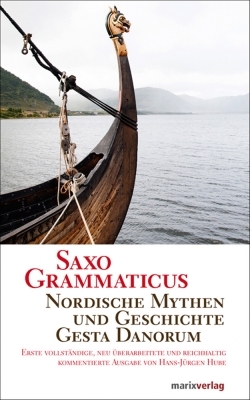 Nation-states began to emerge in Scandinavia during the High Middle Ages. Saxo Grammaticus, author of Gesta Danorum, a chronicle of Danish history, writes that he was motivated by “a passionate zeal to glorify our fatherland” and that “nations [nationes] are in the habit of vaunting the fame of their achievements, and joy in recollecting their ancestors” (p. 155). This patriotic spirit pervades the Norse sagas, in which Denmark, Norway, and Sweden are depicted as distinct nations. Gat notes that most Norse sagas were composed in Iceland and were not patronized, so one cannot claim that their patriotic message was royal propaganda.
Nation-states began to emerge in Scandinavia during the High Middle Ages. Saxo Grammaticus, author of Gesta Danorum, a chronicle of Danish history, writes that he was motivated by “a passionate zeal to glorify our fatherland” and that “nations [nationes] are in the habit of vaunting the fame of their achievements, and joy in recollecting their ancestors” (p. 155). This patriotic spirit pervades the Norse sagas, in which Denmark, Norway, and Sweden are depicted as distinct nations. Gat notes that most Norse sagas were composed in Iceland and were not patronized, so one cannot claim that their patriotic message was royal propaganda.
Finland and Estonia are unusual in that neither truly became nation-states until the early twentieth century. Nonetheless, both nations possessed a distinct ethnocultural identity, which remained remarkably resilient in spite of their subjugation.
The question of German identity was not a subject of philosophical deliberation prior to the modern era, but the idea of Germanness dates back centuries. Late medieval maps of Germany depict a “German nation” united by language and culture. Martin Luther’s tract written to Germany’s nobles in 1520 is entitled “Address to the Christian Nobility of the German Nation.” The Holy Roman Empire was effectively “a German-based political order; it was popularly celebrated for its German base in the political lays of Walter von der Vogelweide and the Minnensingers; and authentic historians like Otto of Freising and Alexander von Roes identified imperial history with German history” (p. 161). A sense of German national identity is evident from the Middle Ages onward.
The Hussite Revolution in the Kingdom of Bohemia had a strong nationalist underpinning. It was essentially a national populist movement that united Czechs from all social classes (nobility, intellectuals, peasants, etc.). The wars in turn strengthened national awareness among Czechs. When Jan Has was tried and executed for heresy, Czech barons protested “the dishonor of our nationality and of the Bohemian land” (p. 164). Among the demands of the leaders of the movement was that foreigners be barred from holding civil offices.
Some scholars have argued that the Polish-Lithuanian Commonwealth solely served the interests of the nobility and that Polish identity excluded the peasantry. This notion is itself a modern invention. Polish national identity transcended class: “. . . no one, from Dugosz to Andrzej Frycz Modrzewski, denied that peasants were an integral part of the nation, based on one common language” (p. 170). Polish peasants played an important role in fighting the Swedes under Charles XII and were loyal to Poland despite their subjugation.
Russian peasants fared even worse than their Polish counterparts, yet they still identified strongly with Russia and revered the Russian Tsar. The Polish occupation of Russia during the Time of Troubles provoked a large-scale national revolt. A volunteer army of peasants is credited with having expelled Polish forces from the Kremlin in 1612. Glinka’s opera A Life for the Tsar dramatizes a legend in which one Russian peasant sacrificed his life in order to divert the Polish army.
A twelfth-century chronicler describes the “nations” around the Baltic Sea in his day:
Many nations [naciones] are seated about this sea. The Danes and the Swedes, whom we call Northmen, occupy the northern coast and all the islands it contains. Along the southern shore dwell the Slavic nations [naciones] of whom, reckoning from the east, the Russians [Ruci] are the first, then the Poles who on the north have the Prussians, on the south the Bohemians and those who are called Moravians and the Carinthians and the Sorbs (p. 183).
European nation-states were also referred to as such in ecclesiastic councils in the Late Middle Ages. Each nation had its own vote and was regarded as a distinct entity. Gat writes that there is no evidence for the claim that the word natio had a different meaning in the Middle Ages. The word has always signified “nation,” or a people united by blood and culture.
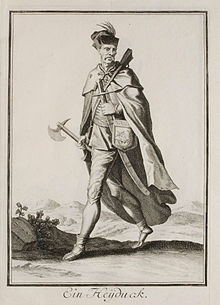 Hungary was formed in the late ninth century from the consolidation of nomadic Finno-Ugric tribes into a single nation under Árpád, known to Hungarians as “the founder of our homeland.” Hungarian national identity was well-established by the Middle Ages. Istaván Bocskai, leader of a Hungarian uprising against the Habsburgs in 1604, wrote in his manifesto, “It should be demanded that every man who loves his country and fatherland stand up for his nation and hasten against our common enemy” (p. 190). Peasant soldiers and brigands (haiduci) echoed this sentiment: “We owe it to our dear country and nation . . . to rise all together and live or die together” (p. 190). The haiduk movement extended throughout Central and Southeastern Europe and had a strong nationalist character. Haiduci were celebrated in national epics and folklore.
Hungary was formed in the late ninth century from the consolidation of nomadic Finno-Ugric tribes into a single nation under Árpád, known to Hungarians as “the founder of our homeland.” Hungarian national identity was well-established by the Middle Ages. Istaván Bocskai, leader of a Hungarian uprising against the Habsburgs in 1604, wrote in his manifesto, “It should be demanded that every man who loves his country and fatherland stand up for his nation and hasten against our common enemy” (p. 190). Peasant soldiers and brigands (haiduci) echoed this sentiment: “We owe it to our dear country and nation . . . to rise all together and live or die together” (p. 190). The haiduk movement extended throughout Central and Southeastern Europe and had a strong nationalist character. Haiduci were celebrated in national epics and folklore.
The Reaper’s War is another good example of a national populist uprising. In 1640, Catalonia revolted against Spain and declared itself an independent republic, which was put under French protection. The rebellion was led largely by peasants. Catalan identity persists to this day; in the 2017 Catalan independence referendum, ninety-two percent of voters voted for independence.
Despite immense regional diversity and internal conflict, a pan-Italian identity nonetheless existed long before Italian unification. Machiavelli writes in the final chapter of The Prince (entitled “Exhortation to Seize Italy and to Free Her from the Barbarians”):
The opportunity to provide Italy with a liberator . . . must not be missed. I have no doubt at all that he would be received with great affection in all those regions that have been inundated by the foreign invasions, as well as with a great thirst for revenge, with absolute fidelity, with devotion and with tears of gratitude. . . . This foreign domination stinks in the nostrils of everyone (p. 81).
Greece became an independent nation in 1830 following a nine-year-long war for independence. Peasant militias played a prominent role in the revolution. Gat points out that in the centuries preceding the revolution there were a number of unsuccessful rebellions against Ottoman rule, which failed “not because modernization inaugurated Greek nationalism, but because Ottoman power greatly declined” (pp. 250-251).
Most Balkan countries had a long history of revolting against the Ottoman Empire prior to gaining independence. One notable revolt is the uprising in Banat, in which, according to Serbian folklore, “six hundred villages arose” (p. 251). Gellner admits that nationalist movements in Southeastern Europe “can be seen as constituting a major problem for the theory, given the backwardness of the Balkans by the standards of industrialization and modernity” (p. 251).
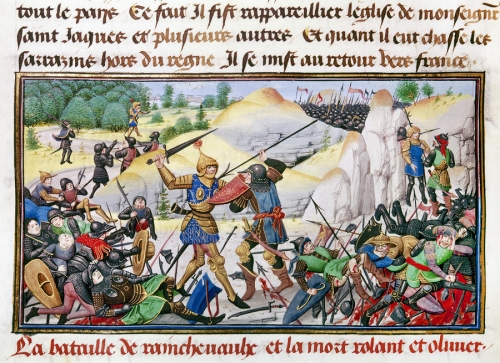
France is an interesting case study given its paradigmatic status as a nation formed from a number of ethnicities. Gat attributes the success of French nation-building to both ethnic blending and state-backed cultural assimilation. By the Middle Ages, a distinct national identity had crystallized. The twelfth-century French abbot Suger refers to France as “our land” and “the mother of us all, of the king and of the commoner” (p. 200). The Song of Roland, which dates to the eleventh century, also makes a reference to “sweet France.” The refusal of French nobility to accept an English King (Edward III) as their monarch was what brought about the Hundred Years’ War. Patriotism was not confined to the elites, as the story of Joan of Arc evinces. Another example is that the peasants’ anger over the nobility’s defeat at the Battle of Poitiers, in which the French King was captured, was partly responsible for triggering the peasant uprisings of the mid-fourteenth century. Gat adds that the peasants “raised the banner of and loudly expressed their allegiance to the king of France” (p. 204).
Loyalty to the monarchy was a fluctuating element of French national identity. The monarch became the “focal point” of nationalistic sentiment during the age of absolutism, but French nationalism became more overly populist as dissatisfaction with the monarchy grew. The French people’s patriotism, though, remained a constant.
France can rightly be cited as a successful example of a nation formed from multiple ethnic components, but Gat emphasizes that ethnic diversity is generally an impediment to national unity. Countries like France and England were only able to form a unified national identity through a centuries-long process of ethnic blending and assimilation.
Experiments in forcing different ethnic groups to coexist in one nation have rarely been successful. Yugoslavia and Czechoslovakia are both good examples. Another example is Cyprus, which began as a binational state but soon was de facto partitioned into two distinct regions; the conflict between Greek and Turkish Cypriots is ongoing. Coexistence is only truly feasible if there is a clear ethnic majority and if the minority groups are willing to accept their second-class status.
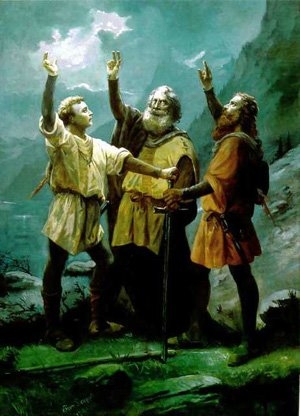 Switzerland is a very rare example of a successful multiethnic state, the exception that proves the rule. Its success cannot easily be replicated because its formation was the result of specific historical contingencies. Switzerland began as a loose military alliance called the Old Swiss Confederation. Central authority was nearly nonexistent, and each canton was a self-governing entity. Switzerland’s mountainous geography further reinforced the autonomy of each canton and prevented political turmoil.
Switzerland is a very rare example of a successful multiethnic state, the exception that proves the rule. Its success cannot easily be replicated because its formation was the result of specific historical contingencies. Switzerland began as a loose military alliance called the Old Swiss Confederation. Central authority was nearly nonexistent, and each canton was a self-governing entity. Switzerland’s mountainous geography further reinforced the autonomy of each canton and prevented political turmoil.
A similar approach has been implemented in Belgium over the past half-century. A series of “state reforms” have transferred more power to the regional scale, granting Flanders and Wallonia more autonomy. This has somewhat eased Belgium’s ethnic tensions, though problems between the regions still exist today, and there is an active Flemish independence movement.
India is another notable example of a multiethnic state. Its success in nation-building can be attributed to its normative Indian identity, that of the country’s ethnolinguistic core, which is upheld by the majority of the population. Nonetheless, India is not free of ethnic conflict (see the Kashmiri Insurgency).
Gat identifies America as a nation founded by Englishmen whose shared heritage was central to American identity. He quotes John Jay:
Providence has been pleased to give this one connected country to one united people – a people descended from the same ancestors, speaking the same language, professing the same religion, attached to the same principles of government, very similar in their manners and customs, and who, by their joint counsels, arms, and efforts, fighting side by side throughout a long and bloody war, have nobly established general liberty and independence (pp. 269-270).
American national identity expanded in the nineteenth century to include Euro-Americans as a whole, creating a distinct American ethnicity. Gat then argues that American identity has since undergone a second shift, incorporating more recent non-white immigrants. He claims that America is an example of a successful multiracial nation whose citizens are united by such things as national holidays, popular tastes, and sports. This is bizarre in light of the rest of the book. Given the many examples of tensions existing between two similar ethnic groups, it is delusional to think that genetically distant races can peacefully coexist in America. To date, America’s experiment in integration has been far from successful.
Gat seems unwilling to discuss the issue of race. It is safer to point out ethnic differences than it is to point out racial differences because one can still maintain the egalitarian pretense that if Italians can become American, non-whites can as well. Of course, the rest of the book does not support this conclusion given its emphasis on kinship and the fact that white ethnic groups are much more genetically similar to each other than they are to other races.
His argument is later undermined again by his discussion of how ethnic homogeneity correlates with the percentage of a nation’s GDP that is directed toward social welfare programs. People are markedly less willing to subsidize welfare programs when they know that their beneficiaries disproportionately belong to an alien group:
Expenditure on social programs totals 14.6 percent of GDP in the United States, as opposed to a European average of 25.5 percent. The authors recognized that these differences, which go back a long way historically, have a variety of causes. They calculate that about half of the difference is . . . rooted in the United States’ ethnic and racial heterogeneity” (p. 322).
Within the United States, welfare policies “vary in proportion to the size of the black population” (p. 322). Race is not the only factor at play here, but this is nonetheless a good indicator that the average white American feels no sense of kinship with blacks, despite the fact that they have lived here for centuries and are well-represented in popular culture (which supposedly defines modern American identity, in Gat’s view).
Apart from the above issue, this book is a great overview of nationalism and the role of ethnicity in history. Nationalism would be legitimate even if it were a recent phenomenon, but it is worth addressing the claims of Leftist theorists, because their ultimate aim is to delegitimize nationalism and bolster the idea that national identity must be transcended. The examples in this book show that “kin-culture” identity is a perennial and universal feature of human civilization, and something that all peoples deserve to uphold.
The conclusion of the book is white-pilling. Most people’s ultimate loyalties still lie with their respective ethnicities and/or nations, and nationalist sentiments today “are anything but non-existent and can be triggered when challenged” (p. 319). This offers cause for optimism for White Nationalists.


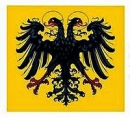
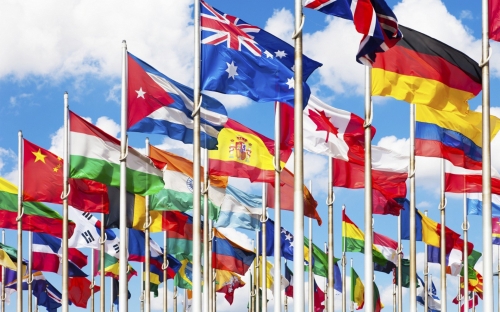

 del.icio.us
del.icio.us
 Digg
Digg


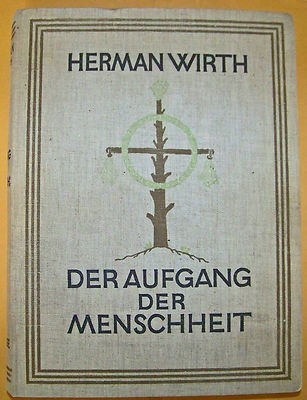 Wirth adopta cette hypothèse et construisit sa propre théorie sur elle, la « théorie hyperboréenne » [2] ou théorie du « cercle culturel de Thulé » [3], qui est le nom grec de la cité mythique se trouvant dans le pays des Hyperboréens. D’après cette théorie, avant la dernière vague de refroidissement mondial, la zone circumpolaire dans l’Océan nord-atlantique abritait des terres habitables dont les habitants furent les créateurs d’un code culturel primordial. Cette culture se forma dans des conditions où l’environnement naturel de l’Arctique n’était pas encore si inhospitalier, et où son climat était similaire au climat tempéré de l’Europe Centrale moderne. Cependant, étaient présents tous les phénomènes annuels et atmosphériques qui peuvent être observés dans l’Arctique aujourd’hui : le jour et la nuit arctiques. Les cycles solaire et lunaire annuels sont structurés différemment de leurs équivalents sous les latitudes moyennes. Ainsi, les fixations symboliques du calendrier, la trajectoire du soleil, de la lune et les constellations du zodiaque avaient forcément une forme différente et des motifs différents.
Wirth adopta cette hypothèse et construisit sa propre théorie sur elle, la « théorie hyperboréenne » [2] ou théorie du « cercle culturel de Thulé » [3], qui est le nom grec de la cité mythique se trouvant dans le pays des Hyperboréens. D’après cette théorie, avant la dernière vague de refroidissement mondial, la zone circumpolaire dans l’Océan nord-atlantique abritait des terres habitables dont les habitants furent les créateurs d’un code culturel primordial. Cette culture se forma dans des conditions où l’environnement naturel de l’Arctique n’était pas encore si inhospitalier, et où son climat était similaire au climat tempéré de l’Europe Centrale moderne. Cependant, étaient présents tous les phénomènes annuels et atmosphériques qui peuvent être observés dans l’Arctique aujourd’hui : le jour et la nuit arctiques. Les cycles solaire et lunaire annuels sont structurés différemment de leurs équivalents sous les latitudes moyennes. Ainsi, les fixations symboliques du calendrier, la trajectoire du soleil, de la lune et les constellations du zodiaque avaient forcément une forme différente et des motifs différents. Wirth présenta ainsi une vision très particulière de la relation entre le matriarcat et le patriarcat dans la culture archaïque de la région méditerranéenne. De son point de vue, les plus anciennes formes de culture en Méditerranée furent celles établies par les porteurs du matriarcat hyperboréen, qui en plusieurs étapes descendirent des régions circumpolaires, de l’Atlantique Nord, par voie de mer (et leurs navires avec des trèfles sur la poupe étaient caractéristiques). C’était le peuple mentionné dans les artefacts du Proche-Orient comme les « peuples de la mer », ou am-uru, d’où le nom ethnique des Amorrites. Le nom de Mo-uru, d’après Wirth, était jadis celui du centre principal des Hyperboréens, mais fut donné à de nouveaux centres sacrés par les natifs du Nord dans leurs vagues migratoires. C’est à ces vagues que nous devons les cultures sumérienne, akkadienne, égyptienne (dont l’écriture prédynastique était linéaire), hittite-hourrite, minoenne, mycénienne, et pélagienne. Toutes ces strates hyperboréennes étaient structurées autour de la figure de la Prêtresse Blanche.
Wirth présenta ainsi une vision très particulière de la relation entre le matriarcat et le patriarcat dans la culture archaïque de la région méditerranéenne. De son point de vue, les plus anciennes formes de culture en Méditerranée furent celles établies par les porteurs du matriarcat hyperboréen, qui en plusieurs étapes descendirent des régions circumpolaires, de l’Atlantique Nord, par voie de mer (et leurs navires avec des trèfles sur la poupe étaient caractéristiques). C’était le peuple mentionné dans les artefacts du Proche-Orient comme les « peuples de la mer », ou am-uru, d’où le nom ethnique des Amorrites. Le nom de Mo-uru, d’après Wirth, était jadis celui du centre principal des Hyperboréens, mais fut donné à de nouveaux centres sacrés par les natifs du Nord dans leurs vagues migratoires. C’est à ces vagues que nous devons les cultures sumérienne, akkadienne, égyptienne (dont l’écriture prédynastique était linéaire), hittite-hourrite, minoenne, mycénienne, et pélagienne. Toutes ces strates hyperboréennes étaient structurées autour de la figure de la Prêtresse Blanche. Entretemps se forma en Asie continentale un pôle culturel qui représentait l’embryon du proto-patriarcat. Wirth associait cette culture au naturalisme primitif, aux cultes phalliques, et à un type de culture martial, agressif et utilitaire, que Wirth considérait comme inférieur et asiatique. Nous avons consacré un volume entier à un exposé plus détaillé des idées de Wirth [7].
Entretemps se forma en Asie continentale un pôle culturel qui représentait l’embryon du proto-patriarcat. Wirth associait cette culture au naturalisme primitif, aux cultes phalliques, et à un type de culture martial, agressif et utilitaire, que Wirth considérait comme inférieur et asiatique. Nous avons consacré un volume entier à un exposé plus détaillé des idées de Wirth [7].
 « Les Argonautes ont fait tomber la première barrière et ce premier écroulement a provoqué de proche en proche la chute de toutes les barrières qui séparaient les peuples les uns des autres, le monde civilisé du monde barbare, le cosmos de tous les au-delà, merveilleux ou épouvantables. »
« Les Argonautes ont fait tomber la première barrière et ce premier écroulement a provoqué de proche en proche la chute de toutes les barrières qui séparaient les peuples les uns des autres, le monde civilisé du monde barbare, le cosmos de tous les au-delà, merveilleux ou épouvantables. »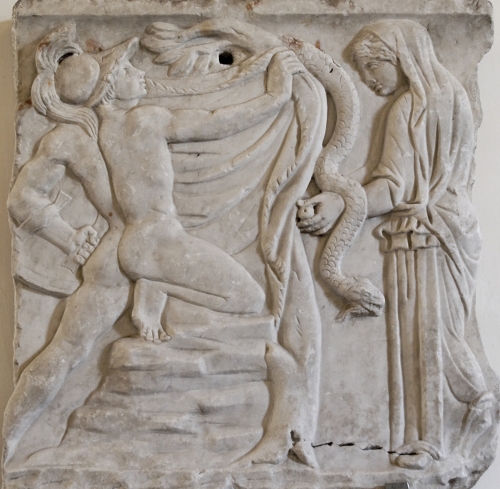

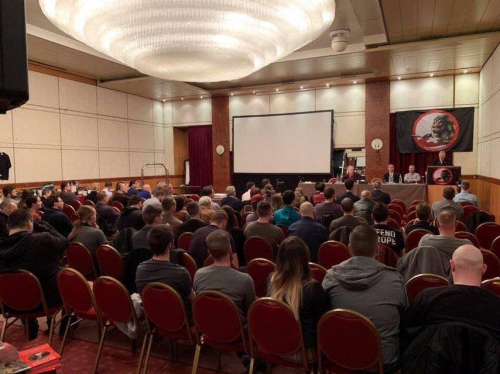
 Le danger du « patriotisme constitutionnel », théorisé par le grand gourou du système en Allemagne, Jürgen Habermas, est celui d’un état d’esprit qui vénère la norme, et rien que la norme, et évacue la force, et même et surtout la simple force des choses, écrit le politologue français d’origine libanaise Zaki Laïdi. En évacuant toute force et toute simple force des choses, le patriotisme constitutionnel, cher à Habermas et défendu avec jactance par Daniel Cohn-Bendit et Guy Verhofstadt, est un pur déni du réel, qui place l’Europe dans un état de faiblesse très inquiétant, tout en interdisant les remèdes, d’avance condamnés comme étant les expressions morbides du populisme, nouveau croquemitaine des intellocrates et des médiacrates, au service de la superclasse.
Le danger du « patriotisme constitutionnel », théorisé par le grand gourou du système en Allemagne, Jürgen Habermas, est celui d’un état d’esprit qui vénère la norme, et rien que la norme, et évacue la force, et même et surtout la simple force des choses, écrit le politologue français d’origine libanaise Zaki Laïdi. En évacuant toute force et toute simple force des choses, le patriotisme constitutionnel, cher à Habermas et défendu avec jactance par Daniel Cohn-Bendit et Guy Verhofstadt, est un pur déni du réel, qui place l’Europe dans un état de faiblesse très inquiétant, tout en interdisant les remèdes, d’avance condamnés comme étant les expressions morbides du populisme, nouveau croquemitaine des intellocrates et des médiacrates, au service de la superclasse. Après le pompage des données sensibles de nos entreprises les plus performantes, qui se poursuit allègrement, sans rencontrer ni critiques ni résistances, une nouvelle arme a été sortie de la panoplie américaine : le droit. Depuis une dizaine d’années, depuis la crise de 2008, de grandes entreprises européennes subissent les foudres des procureurs du département de la Justice américaine et l’assaut des agences de régulations financières. Elles sont accusées de violer les embargos imposés à Cuba, à la Corée du Nord et surtout à l’Iran. Les amendes qu’on leur inflige montent à des millions voire des milliards de dollars. Tour à tour, Siemens, la banque ABN Amro, Technip, la BNP, Alstom, la Société Générale, etc. ont été dans le collimateur ; ces multinationales européennes figurent au top dix des plus lourdes sanctions imposées par Washington, en attendant d’être rejointes demain par Airbus ou de passer sous pavillon américain, écrit Ali Laïdi, chercheur auprès de l’IRIS et spécialiste des guerres économiques. Cette attaque systématique et continue contre nos entreprises est le résultat de la doctrine Clinton, car, depuis qu’elle a été énoncée, les Etats-Unis n’ont plus d’alliés mais se trouvent face à des « cibles étrangères » qu’il convient de viser et de frapper quand elles risquent de dépasser en ampleur leurs équivalentes américaines ou de développer des technologies supérieures à celles créées par leurs concurrentes d’Outre-Atlantique. Les attentats du 11 septembre 2001 contre les tours jumelles à New York ont servi de prétexte, sous Bush II, pour planétariser des lois qui ne s’adressaient, jusqu’alors, qu’aux entreprises et aux citoyens américains. Les terroristes wahhabites ont bon dos : l’action terroriste spectaculaire qu’on leur attribue a permis de lancer une attaque systématique contre le véritable ennemi européen, dont il faut, par la coercition juridique, vassaliser les meilleures entreprises, surtout en Allemagne et en France.
Après le pompage des données sensibles de nos entreprises les plus performantes, qui se poursuit allègrement, sans rencontrer ni critiques ni résistances, une nouvelle arme a été sortie de la panoplie américaine : le droit. Depuis une dizaine d’années, depuis la crise de 2008, de grandes entreprises européennes subissent les foudres des procureurs du département de la Justice américaine et l’assaut des agences de régulations financières. Elles sont accusées de violer les embargos imposés à Cuba, à la Corée du Nord et surtout à l’Iran. Les amendes qu’on leur inflige montent à des millions voire des milliards de dollars. Tour à tour, Siemens, la banque ABN Amro, Technip, la BNP, Alstom, la Société Générale, etc. ont été dans le collimateur ; ces multinationales européennes figurent au top dix des plus lourdes sanctions imposées par Washington, en attendant d’être rejointes demain par Airbus ou de passer sous pavillon américain, écrit Ali Laïdi, chercheur auprès de l’IRIS et spécialiste des guerres économiques. Cette attaque systématique et continue contre nos entreprises est le résultat de la doctrine Clinton, car, depuis qu’elle a été énoncée, les Etats-Unis n’ont plus d’alliés mais se trouvent face à des « cibles étrangères » qu’il convient de viser et de frapper quand elles risquent de dépasser en ampleur leurs équivalentes américaines ou de développer des technologies supérieures à celles créées par leurs concurrentes d’Outre-Atlantique. Les attentats du 11 septembre 2001 contre les tours jumelles à New York ont servi de prétexte, sous Bush II, pour planétariser des lois qui ne s’adressaient, jusqu’alors, qu’aux entreprises et aux citoyens américains. Les terroristes wahhabites ont bon dos : l’action terroriste spectaculaire qu’on leur attribue a permis de lancer une attaque systématique contre le véritable ennemi européen, dont il faut, par la coercition juridique, vassaliser les meilleures entreprises, surtout en Allemagne et en France.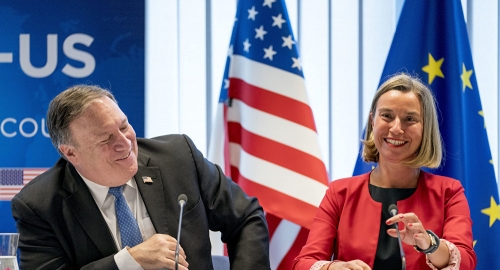


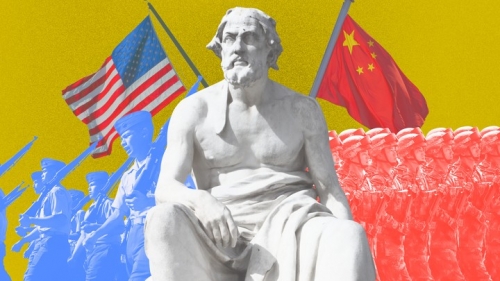
 Le sort des cadres chinois de Huawei, poursuivis par la « justice » américaine, laisse préfigurer le pire aux Européens qui transgresseraient les interdits formulés par le Deep State américain. Le récit que vient de nous livrer Frédéric Pierucci dans son livre intitulé « Le piège américain » est affolant : ce cadre d’Alstom a été emprisonné pendant de longs mois aux Etats-Unis pour faire chanter les dirigeants de l’entreprise française qui ont fini par la céder à un consortium américain, avec toute la complaisance de Macron.
Le sort des cadres chinois de Huawei, poursuivis par la « justice » américaine, laisse préfigurer le pire aux Européens qui transgresseraient les interdits formulés par le Deep State américain. Le récit que vient de nous livrer Frédéric Pierucci dans son livre intitulé « Le piège américain » est affolant : ce cadre d’Alstom a été emprisonné pendant de longs mois aux Etats-Unis pour faire chanter les dirigeants de l’entreprise française qui ont fini par la céder à un consortium américain, avec toute la complaisance de Macron.  Face à cette puissance numérique du tout-virtuel, du Big Data, du « hors sol » et du « cloud », la Chine –et je le dis avec amertume parce que j’aurais voulu que ce fut notre Europe qui le fasse- formule le projet intéressant des « routes de la soie », propose ainsi une organisation continentale, celle des géomètres romains, aurait dit Carl Schmitt, renoue avec la pensée du développement chez Friedrich List, entend vertébrer le monde plutôt que le fluidifier et le sublimer dans le « cloud ». Elle parie pour le temps long. Face à cette tâche qu’elle aurait dû suggérer et entreprendre elle-même, l’Europe, dit Empereur, « a souscrit béatement au grand récit de la mondialisation heureuse et de la fin de l’histoire », annoncée au début des années 1990 par Francis Fukuyama. En souscrivant à ces fables sans consistance, elle a évité ainsi la pensée du long terme, que Chinois, sur le plan tellurique, et Américains, sur le plan numérique, ont pourtant toujours eu en tête. Le présentisme obtus des Européens est une erreur fatale. Ce « présent idéal », mais figé, correspondait peut-être à des temps désormais révolus, ceux de la coexistence pacifique qui édulcorait la guerre froide, ceux des Trente Glorieuses qui se sont muées en Trente Piteuses, ou encore ceux de la perestroïka de Gorbatchev. Or le monde est redevenu « normal », c’est-à-dire multipolaire et conflictuel, précise Empereur. Voilà pourquoi un projet de refondation est impératif pour l’UE, aujourd’hui, alors que les peuples renâclent : les Européens, en effet, ont le sentiment diffus que leurs institutions bruxelloises ne sont qu’un fatras technocratique oppressant qui s’auto-justifie par une idéologie vertuiste, tissée de repentance et de culpabilité. Les Européens, ajoute Empereur, « ne disposent ni de la puissance numérique actuellement dominée par les Américains et sans doute demain par les Chinois et sont coupés de toute profondeur stratégique non seulement par leur situation géographique de petit cap de l’Asie mais aussi par l’interdiction absolue qui leur est faite, par leurs alliés anglo-saxons, de s’entendre avec la Russie dans une perspective eurasiatique. (…). Cette stratégie d’interdiction géopolitique est totalement contraire aux intérêts européens ». Pire : ces dernières semaines, à l’occasion de la soixante-troisième conférence sur la sécurité à Munich, Mike Pence, porte-paroles du gouvernement américain, a tenté de forcer Merkel à refuser et à saborder le projet de gazoduc Nord Stream 2 et a déconseillé aux Européens de commercer avec l’Iran. Macron prendra le relais en répétant les admonestations de Pence, ruinant ainsi le binôme franco-allemand, reposant sur une volonté d’émancipation européenne. Sans le gaz russe, l’Europe germanique et bénéluxienne ne peut tout simplement pas survivre ; sans l’apport du commerce iranien, l’Europe est condamnée à la stagnation et à ne disposer que de fonds réduits pour ses « recherches et développements », alors que ceux-ci sont urgentissimes pour rattraper ses retards dans le numérique et dans d’autres domaines de pointe.
Face à cette puissance numérique du tout-virtuel, du Big Data, du « hors sol » et du « cloud », la Chine –et je le dis avec amertume parce que j’aurais voulu que ce fut notre Europe qui le fasse- formule le projet intéressant des « routes de la soie », propose ainsi une organisation continentale, celle des géomètres romains, aurait dit Carl Schmitt, renoue avec la pensée du développement chez Friedrich List, entend vertébrer le monde plutôt que le fluidifier et le sublimer dans le « cloud ». Elle parie pour le temps long. Face à cette tâche qu’elle aurait dû suggérer et entreprendre elle-même, l’Europe, dit Empereur, « a souscrit béatement au grand récit de la mondialisation heureuse et de la fin de l’histoire », annoncée au début des années 1990 par Francis Fukuyama. En souscrivant à ces fables sans consistance, elle a évité ainsi la pensée du long terme, que Chinois, sur le plan tellurique, et Américains, sur le plan numérique, ont pourtant toujours eu en tête. Le présentisme obtus des Européens est une erreur fatale. Ce « présent idéal », mais figé, correspondait peut-être à des temps désormais révolus, ceux de la coexistence pacifique qui édulcorait la guerre froide, ceux des Trente Glorieuses qui se sont muées en Trente Piteuses, ou encore ceux de la perestroïka de Gorbatchev. Or le monde est redevenu « normal », c’est-à-dire multipolaire et conflictuel, précise Empereur. Voilà pourquoi un projet de refondation est impératif pour l’UE, aujourd’hui, alors que les peuples renâclent : les Européens, en effet, ont le sentiment diffus que leurs institutions bruxelloises ne sont qu’un fatras technocratique oppressant qui s’auto-justifie par une idéologie vertuiste, tissée de repentance et de culpabilité. Les Européens, ajoute Empereur, « ne disposent ni de la puissance numérique actuellement dominée par les Américains et sans doute demain par les Chinois et sont coupés de toute profondeur stratégique non seulement par leur situation géographique de petit cap de l’Asie mais aussi par l’interdiction absolue qui leur est faite, par leurs alliés anglo-saxons, de s’entendre avec la Russie dans une perspective eurasiatique. (…). Cette stratégie d’interdiction géopolitique est totalement contraire aux intérêts européens ». Pire : ces dernières semaines, à l’occasion de la soixante-troisième conférence sur la sécurité à Munich, Mike Pence, porte-paroles du gouvernement américain, a tenté de forcer Merkel à refuser et à saborder le projet de gazoduc Nord Stream 2 et a déconseillé aux Européens de commercer avec l’Iran. Macron prendra le relais en répétant les admonestations de Pence, ruinant ainsi le binôme franco-allemand, reposant sur une volonté d’émancipation européenne. Sans le gaz russe, l’Europe germanique et bénéluxienne ne peut tout simplement pas survivre ; sans l’apport du commerce iranien, l’Europe est condamnée à la stagnation et à ne disposer que de fonds réduits pour ses « recherches et développements », alors que ceux-ci sont urgentissimes pour rattraper ses retards dans le numérique et dans d’autres domaines de pointe.  Les dépenses militaires américaines, surtout après l’aventure vietnamienne et après le projet de « guerre des étoiles » cher à Reagan, ont servi à lancer une industrie numérique qui assure la domination américaine sur la planète entière. Les Européens n’ont jamais eu le réflexe de coordonner leurs actions pour être à l’avant-garde des innovations scientifiques et technologiques.
Les dépenses militaires américaines, surtout après l’aventure vietnamienne et après le projet de « guerre des étoiles » cher à Reagan, ont servi à lancer une industrie numérique qui assure la domination américaine sur la planète entière. Les Européens n’ont jamais eu le réflexe de coordonner leurs actions pour être à l’avant-garde des innovations scientifiques et technologiques.
 Par la suite, engagé politiquement dans des groupuscules activistes, j’ai découvert avec un infini bonheur que Hergé avait fréquenté des personnages qui me fascinaient, comme Léon Degrelle, dont j’avais lu l’épopée militaire, qu’il avait dessiné une aventure anticommuniste au pays des Soviets, album mythique, introuvable, dont j’ai pu lire pour la première fois les bonnes pages dans le mensuel anticommuniste Impact, au tout début des années 70.
Par la suite, engagé politiquement dans des groupuscules activistes, j’ai découvert avec un infini bonheur que Hergé avait fréquenté des personnages qui me fascinaient, comme Léon Degrelle, dont j’avais lu l’épopée militaire, qu’il avait dessiné une aventure anticommuniste au pays des Soviets, album mythique, introuvable, dont j’ai pu lire pour la première fois les bonnes pages dans le mensuel anticommuniste Impact, au tout début des années 70. Je pense aussi que la grande vague de mise en cause d’Hergé est finie. Après la mort d’Hergé, en 1983, et alors que le politiquement correct n’avait pas encore suscité ses contre-poisons, on pouvait craindre une opération de diabolisation définitive. Mais ce ne fut pas le cas, et aujourd’hui il n’y a plus de « scandales » à découvrir. Pierre Assouline, dans sa biographie, a exploré les moindres courriers du père de Tintin. Les psychanalystes ont étudié chaque album, etc. Un recentrage sur l’œuvre s’est opéré.
Je pense aussi que la grande vague de mise en cause d’Hergé est finie. Après la mort d’Hergé, en 1983, et alors que le politiquement correct n’avait pas encore suscité ses contre-poisons, on pouvait craindre une opération de diabolisation définitive. Mais ce ne fut pas le cas, et aujourd’hui il n’y a plus de « scandales » à découvrir. Pierre Assouline, dans sa biographie, a exploré les moindres courriers du père de Tintin. Les psychanalystes ont étudié chaque album, etc. Un recentrage sur l’œuvre s’est opéré.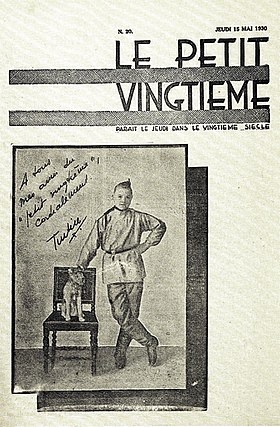 Breizh-info.com :
Breizh-info.com : 
 Comme le remarqueront les lecteurs du Songe d’Empédocle, le jeune Padraig est du genre à avoir « la nuque raide », pour citer l’Ancien Testament, une fois n’est pas coutume. Je veux dire que ses origines hiberniennes et brabançonnes ne prédisposent en rien cet homme archaïque à la soumission, fût-elle grimée en divertissement festif, ni à la docile acceptation des dogmes, quelle que soit leur date de fabrication. Druide et barde à la fois, il ne peut que suffoquer dans l’étouffoir spirituel que représente son époque, définie en ces termes par le regretté Philippe Muray : « Le grand bain multicolore du consentir liquéfiant ».
Comme le remarqueront les lecteurs du Songe d’Empédocle, le jeune Padraig est du genre à avoir « la nuque raide », pour citer l’Ancien Testament, une fois n’est pas coutume. Je veux dire que ses origines hiberniennes et brabançonnes ne prédisposent en rien cet homme archaïque à la soumission, fût-elle grimée en divertissement festif, ni à la docile acceptation des dogmes, quelle que soit leur date de fabrication. Druide et barde à la fois, il ne peut que suffoquer dans l’étouffoir spirituel que représente son époque, définie en ces termes par le regretté Philippe Muray : « Le grand bain multicolore du consentir liquéfiant ». J’en parle dans La Source pérenne, qui retrace mon itinéraire spirituel : en dégageant les ruines d’un sanctuaire païen du Bas Empire, en nettoyant tessons et monnaies de bronze portant la fière devise Soli invicto comiti, en reconstruisant les murs du fanum gallo-romain (car en plus d’être terrassier, j’ai aussi joué au maçon – l’archéologie comme humanisme intégral), j’ai pris conscience de mon identité profonde, antérieure. Ce paganisme ne m’a pas été « enseigné » stricto sensu puisque mon entourage était de tendance rationaliste. Je l’ai redécouvert seul… à moins que les Puissances – celles du sanctuaire ? – ne se soient servies de moi. Les lectures, les fouilles, le goût du latin puis du grec, des expériences de type panthéiste à l’adolescence dans nos forêts, tout cela a fait de moi un polythéiste dès l’âge de seize ans. Depuis, je n’ai pas dévié et n’ai aucunement l’intention de le faire : je creuse mon sillon, en loyal paganus.
J’en parle dans La Source pérenne, qui retrace mon itinéraire spirituel : en dégageant les ruines d’un sanctuaire païen du Bas Empire, en nettoyant tessons et monnaies de bronze portant la fière devise Soli invicto comiti, en reconstruisant les murs du fanum gallo-romain (car en plus d’être terrassier, j’ai aussi joué au maçon – l’archéologie comme humanisme intégral), j’ai pris conscience de mon identité profonde, antérieure. Ce paganisme ne m’a pas été « enseigné » stricto sensu puisque mon entourage était de tendance rationaliste. Je l’ai redécouvert seul… à moins que les Puissances – celles du sanctuaire ? – ne se soient servies de moi. Les lectures, les fouilles, le goût du latin puis du grec, des expériences de type panthéiste à l’adolescence dans nos forêts, tout cela a fait de moi un polythéiste dès l’âge de seize ans. Depuis, je n’ai pas dévié et n’ai aucunement l’intention de le faire : je creuse mon sillon, en loyal paganus. En 1992, comme il n’existait aucune revue sur le paganisme qui correspondît à mes attentes de rigueur et d’ouverture, j’ai décidé de relancer Antaios, deuxième du nom, dans le but de défendre et d’illustrer la vision païenne du monde, et aussi, je le concède, de me faire quelques ennemis. Jünger m’a écrit pour m’encourager ; il me cite d’ailleurs dans l’ultime volume de ses mémoires, Soixante-dix s’efface. Pour son centième anniversaire en 1995, je lui ai fait parvenir la réplique en argent de la rouelle gallo-romaine qui servait d’emblème à Antaios.
En 1992, comme il n’existait aucune revue sur le paganisme qui correspondît à mes attentes de rigueur et d’ouverture, j’ai décidé de relancer Antaios, deuxième du nom, dans le but de défendre et d’illustrer la vision païenne du monde, et aussi, je le concède, de me faire quelques ennemis. Jünger m’a écrit pour m’encourager ; il me cite d’ailleurs dans l’ultime volume de ses mémoires, Soixante-dix s’efface. Pour son centième anniversaire en 1995, je lui ai fait parvenir la réplique en argent de la rouelle gallo-romaine qui servait d’emblème à Antaios. Vous citez volontiers Ernst Jünger parmi vos maîtres, vos créanciers spirituels. Comment avez-vous rencontré son œuvre ?
Vous citez volontiers Ernst Jünger parmi vos maîtres, vos créanciers spirituels. Comment avez-vous rencontré son œuvre ?







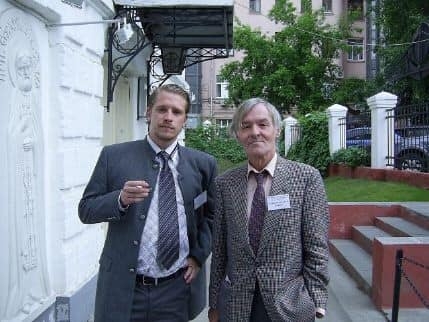


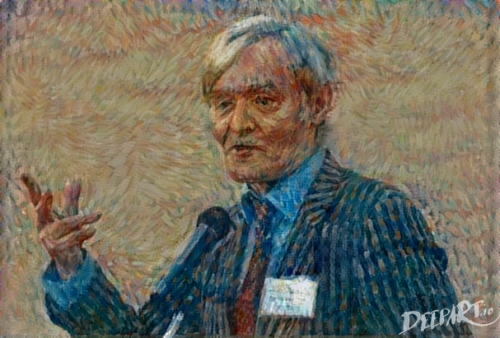











 Mark Sedgwick is an English scholar of Western Esotericism and Islam. He is Professor of Arab and Islamic Studies at Aarhus University in Denmark. He is the author of six books, including Against the Modern World: Traditionalism and the Secret Intellectual History of the Twentieth Century (Oxford University Press, 2004), which I can highly recommend, and Western Sufism: From the Abbasids to the New Age (Oxford University Press, 2016).
Mark Sedgwick is an English scholar of Western Esotericism and Islam. He is Professor of Arab and Islamic Studies at Aarhus University in Denmark. He is the author of six books, including Against the Modern World: Traditionalism and the Secret Intellectual History of the Twentieth Century (Oxford University Press, 2004), which I can highly recommend, and Western Sufism: From the Abbasids to the New Age (Oxford University Press, 2016). I cannot evaluate the accuracy of Sindre Bangstad’s chapter on “Bat Ye’or and Eurabia,” because I have never read Ye’or. But must note that this chapter has a carping and tendentious attitude that violates Sedgwick’s stated desire to maintain a neutral and scholarly tone. The running heads of the chapter also read “Bay Ye’or and Eurabia.”
I cannot evaluate the accuracy of Sindre Bangstad’s chapter on “Bat Ye’or and Eurabia,” because I have never read Ye’or. But must note that this chapter has a carping and tendentious attitude that violates Sedgwick’s stated desire to maintain a neutral and scholarly tone. The running heads of the chapter also read “Bay Ye’or and Eurabia.”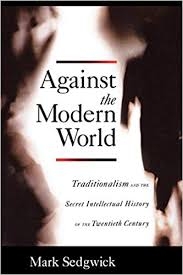 One can create political policies. One can create legal codes. One can build the damned wall. But it is not in our power to manufacture a new culture. But neither can we manufacture a simple tomato. We can, however, work with forces we ultimately do not understand or control — nature itself — to grow tomatoes. We can clear a space, plant a seed, weed, water, and fertilize — and then wait. We can do the same in the metapolitical realm: clear spaces by deconstructing false ideas, plant identitarian and ethnonationalist seeds, and tend what grows.
One can create political policies. One can create legal codes. One can build the damned wall. But it is not in our power to manufacture a new culture. But neither can we manufacture a simple tomato. We can, however, work with forces we ultimately do not understand or control — nature itself — to grow tomatoes. We can clear a space, plant a seed, weed, water, and fertilize — and then wait. We can do the same in the metapolitical realm: clear spaces by deconstructing false ideas, plant identitarian and ethnonationalist seeds, and tend what grows. To top it off, the whole essay reads like a hastily assembled and barely edited draft, with occasional fragments of Yoda-like syntax.
To top it off, the whole essay reads like a hastily assembled and barely edited draft, with occasional fragments of Yoda-like syntax.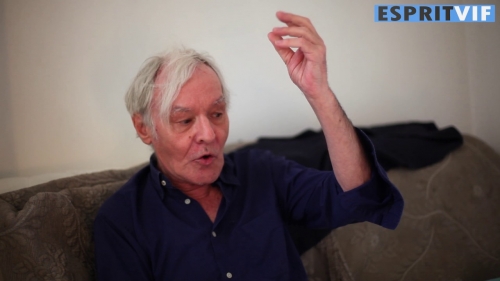
 Ces points de désaccord ne suffisaient pas à rendre le personnage infréquentable et persona non grata. Ce qui me liait avant tout à Guillaume Faye, c’était son combat pour sauver notre civilisation, c’est-à-dire avant tout la race blanche. On aura beau nommer nos enfants et nos petits-enfants Sigurd ou Leonidas, et leur transmettre tout notre patrimoine d’Européens, comment pourrons-nous nous reconnaître en eux si nous avons affaire à des métèques et des mulâtres ? Je voue à Guillaume Faye un immense respect pour être resté fidèle à cette cause primordiale, à savoir défendre notre droit à demeurer ce que nous sommes.
Ces points de désaccord ne suffisaient pas à rendre le personnage infréquentable et persona non grata. Ce qui me liait avant tout à Guillaume Faye, c’était son combat pour sauver notre civilisation, c’est-à-dire avant tout la race blanche. On aura beau nommer nos enfants et nos petits-enfants Sigurd ou Leonidas, et leur transmettre tout notre patrimoine d’Européens, comment pourrons-nous nous reconnaître en eux si nous avons affaire à des métèques et des mulâtres ? Je voue à Guillaume Faye un immense respect pour être resté fidèle à cette cause primordiale, à savoir défendre notre droit à demeurer ce que nous sommes.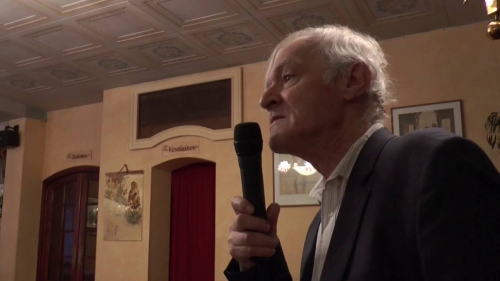
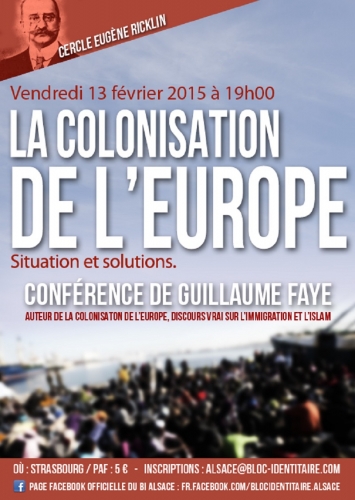 Aveva stroncato il gesto del gendarme Beltrame, morto per fermare un islamista. Che ne pensa?
Aveva stroncato il gesto del gendarme Beltrame, morto per fermare un islamista. Che ne pensa?